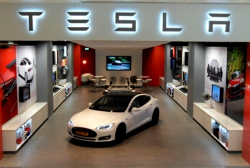
— A Tesla regenerative braking lawsuit alleges Tesla Model S cars and Model X SUVs have dangerous braking systems that cause the cars to crash in snowy or icy conditions.
The proposed regenerative braking class-action lawsuit includes all U.S. consumers who purchased 2012-2017 Tesla Model S cars and 2016-2017 Tesla Model X SUVs.
The plaintiffs say they purchased a new 2016 Tesla Model X in September 2016 and in April 2017, plaintiff Roy Wiseman was driving in California and started running into snow at higher elevations.
Wiseman says he slowed down due to the snow, and as he went around a curve he removed his foot slightly off the accelerator pedal to slow down even more. This caused the regenerative braking system to activate and apply negative torque to the wheels. The Model X allegedly slid off the road and went down a mountainside, crashing into trees and branches.
Wiseman and his passenger remained in the severely damaged Model X stranded in the snow for more than an hour waiting for help.
The lawsuit says the Tesla Model S and Tesla Model X are equipped with either one or two electric motors that use electricity from the vehicle’s lithium-ion battery packs to rotate either the rear wheels or all four wheels.
When the driver presses the accelerator pedal, the electric energy transfers from the lithium-ion battery packs to the electric motor(s) to propel the vehicle and when the driver releases the accelerator pedal while the vehicle is moving, the electric motor(s) begin to act as power generators. This turns the kinetic energy into electricity to recharge the lithium-ion batteries.
While a gasoline-powered car will generally coast when a driver releases the accelerator pedal, Tesla vehicles begin to rapidly decelerate as a result of power regeneration. Tesla calls this process “regenerative braking," but unlike almost every other vehicle with regenerative braking, the Tesla system activates when the driver lets off the accelerator pedal.
Other vehicles, like the Toyota Prius, only activate regenerative braking when the driver presses the brake pedal, retaining the ability to coast.
The lawsuit alleges the regenerative braking systems used in both the Model S and Model X create a risk for the vehicles to lose control in snowy conditions because the systems make the vehicles unable to coast. According to the plaintiffs, a driver is put in danger of losing control on icy roads due to the mandatory braking the vehicle imposes on the driver.
Drivers know that sharp, sudden and excessive braking or downshifting isn't a good idea on icy or snowy roads because braking can cause vehicles to shift their weight and become unbalanced. But according to the plaintiffs, Tesla has known since 2007 that the regenerative braking systems create that very danger.
In 2007, Tesla posted a message on its website that said, in part, the automaker had “developed and verified [a] safety feature” called “regen control” to limit the regenerative braking if the vehicle’s rear wheels start to slip. But according to the lawsuit, it's been 10 years and the Tesla vehicles still suffer from losing stability when the regenerative braking is engaged in snow or ice.
The Wiseman's also say the braking system has limitations, including not functioning when the vehicle’s battery is too full.
The plaintiffs say they wouldn't have bought the SUV if Tesla would have told them the regenerative braking system was allegedly defective and dangerous.
The Tesla regenerative braking system lawsuit was filed in the U.S. District Court for the Central District of California - Roy and Marites Wiseman, et al., v. Tesla, Inc., et al.
The plaintiffs are represented by The Margarian Law Firm.




